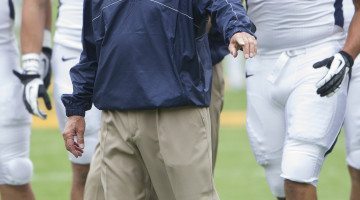
Photo courtesy of Steve Martarano.
Cameron Oliver attempts to block a shot against the University of the Pacific on Saturday, Nov. 21in the Alex G. Spanos Center.
By Jack Rieger
Nevada basketball’s identity under Eric Musselman has been revealed after just four games; they are relentlessly aggressive.
If Nevada basketball was a boxer, they’d be Kimbo Slice. They don’t have excellent technique like Muhammad Ali, and they aren’t patient like Floyd Mayweather. Instead their strategy is to turn every game into a brawl, and hopefully by the final whistle they’ve worn down their opponent after two hours of body shots and transition baskets.
This isn’t something that’s happened by accident; it’s a conscious choice made by coach Eric Musselman, who personifies his team’s confrontational style of play.
Musselman made it very clear in the offseason he wanted Nevada to play with pace and to be physically imposing. Through their first four games, Nevada is tied for 27th in the country in free throws made per game. Their most outstanding player thus far, senior Marqueze Coleman, leads the entire country in free throws made (43) and free throw attempts (53). He’s also 12th in the nation in scoring at 24.8 points per game.
Not only is Nevada’s offense benefiting from their physical style of play, their defense has also been elevated. The Wolf Pack ranks 25th in the country in opponent field goal percentage. They also have the fourth most blocks in the NCAA and they’re tied for 20th in rebounds per game. Rebounding machine AJ West has averaged 11.3 boards per game, six being offensive boards, which is a direct result of Nevada’s big men sprinting in transition and cleaning up shots around the rim.
Nevada’s transformation into a run’n’gun team isn’t a result of talented new recruits or raw ability; it’s a conscious decision the team has made to adopt a proactive, urgent attitude where they are the aggressor. They dictate the pace of the game and force their opponent to react.
The primary reason Nevada’s strategy has worked well this season is because they aren’t an effective outside shooting team, and when they decide to push the pace in transition they are taking shots right around the basket. A good chunk of Nevada’s scoring comes via the free throw line, and you don’t have to be an excellent shooter to make a free throw.
Another advantage of Musselman’s assertive system: it’s just that — a system. It doesn’t depend on Musselman’s ability to recruit five star athletes, and it doesn’t depend on any one player. All the system needs to operate effectively is five guys committed to playing with great energy every night. In other words, it’s sustainable.
Of course there are some disadvantages to playing ultra-aggressively every night. In their third game of the season against Hawaii, Musselman was forced to sit Marqueze Coleman on the bench after Coleman committed two early fouls. Despite a commendable second half effort, Nevada dug themselves in too deep of a first half hole and lost 76-75.
Secondly, the college basketball season can be an exhausting few months for a young team, especially when that team is committed to dictating an aggressive pace. Nevada doesn’t have great guard depth, and an injury to Coleman or Lindsey Drew would be devastating for their chances of making a post-season run.
After a 3-1 start to their young season, including an 85-82 double-overtime win at Pacific on Saturday night, Nevada has revealed their basketball identity. They are going to try and run their opponent out of the gym every night with energy, attitude and aggressiveness.
They are going to throw the first punch.
Jack Rieger can be reached at jrieger@sagebrush.unr.edu and on Twitter @JackRieger.











